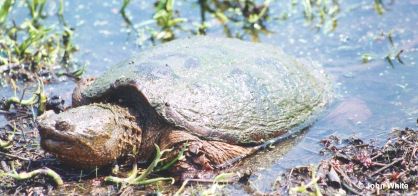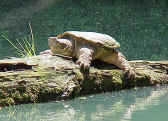|
Snapping Turtle: Chelydra serpentina, Dangers: While it is known for its aggressive personality and tough jaws, which can inflict dangerous wounds, the snapping turtle does not usually become vicious except when disturbed while out of its aquatic habitat. Description: It is the largest freshwater turtle living in the Chesapeake Bay-an adult snapper may reach more than 70 pounds, but average weight is around 35 pounds-inhabiting slow-moving rivers, ponds and marshy estuaries and rarely leaving the water except to bask. The snapping turtle is easy to identify. Its head is large, with strong jaws and two barbels on the chin. The snapper's carapace is often brown, black, olive or tan, and the plastron, or underside of the carapace, is unusually small, yellow or cream-colored, sometimes with dark markings. The turtle's skin can be brown, black, gray or tan, and the legs are powerful and heavily scaled, ending in webbed feet with long claws. Its tail also makes it easy to identify: it is as long as or longer than the carapace, with three rows of scales. When disturbed, the snapper will release an unpleasant anal musk. Females are usually smaller than males. Snapping turtles live most of their lives in the water, preferring shallow ponds, canals and streams but sometimes living in deeper, slow-moving rivers or lakes. During the day the snapping turtle may bury itself in soft mud or sand, waiting for prey, and at night it will forage or actively seek prey. Belying its reputation for aggression, the snapper will usually avoid confrontation while in the water, but will strike rapidly, reaching forward and snapping with their beaks, if disturbed on land. If its water source dries up, a snapping turtle may migrate long distances to find water. Life Cycle: Male snapping turtles are usually sexually mature by age five; females may take two or more years longer (maturity depends more on weight than age). Mating can take place sporadically over an extended period, from April to November. Many females return each year to the same area to lay their eggs. A female will usually excavate her nest at night or in the morning, digging in an open, sandy spot near vegetation and detritus. The nest is usually between three and seven inches deep, bowl-shaped, in which she will deposit between 20 and 40 eggs. Larger clutches are not uncommon. Large females tend to lay more eggs than smaller ones. Incubation usually takes place within three months but can extend to more than 120 days. The roughly one-inch hatchlings carry small yolk sacs for several days under their plastrons, which they later absorb. Their egg tooth falls off in several weeks. Meanwhile the young will hide and make their way to water. During this most vulnerable period many hatchlings fall prey to birds such as hawks and herons, fish, snakes, alligators, or other turtles. In winter snapping turtles will reduce their activity and gradually enter
hibernation by late autumn, around November. They choose secluded areas inside
logs, a mud bank, or beneath an overhanging tree, and bury themselves in soft
mud. They need little oxygen during this period and can absorb most of what they
need through their skin. Some snappers never become totally dormant, even in
cold New England winters, and some have been seen crawling beneath ice. |


